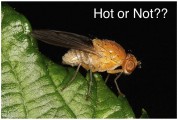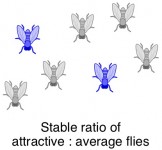 For most animal species, males must compete with one another to win the attention of a female. This competition can involve active sparring – for example, bighorn sheep will sometimes clash heads over a lady sheep. For other animals, such as the peacock, the competition is more about attractiveness than about fighting ability. Good looks can help for human males too, though sometimes all it takes is a display of better-than-average grammatical skills.
For most animal species, males must compete with one another to win the attention of a female. This competition can involve active sparring – for example, bighorn sheep will sometimes clash heads over a lady sheep. For other animals, such as the peacock, the competition is more about attractiveness than about fighting ability. Good looks can help for human males too, though sometimes all it takes is a display of better-than-average grammatical skills.
So if more attractive guys have a better shot at getting the girl, and hence at having (attractive) babies, shouldn’t the population as a whole be getting more handsome with every generation?
Well. . . it’s not, and it doesn’t. A study published this week in PNASProceedings of the National Academy of Sciences demonstrates that the percentage of attractive male flies in a given population eventually reaches a plateau. Though attractive males have a mating advantage, the frequency of attractive genes in a population reaches a limit. In other words, even though the unattractive flies might have less of a shot at making babies, there will still always be unattractive flies.

Attractiveness is complex and subjective for humans, but it’s much more straightforward for flies. Male flies (specifically, male Drosophila serrata) emit pheromones that females find attractive. These pheromones are really eight different hydrocarbons produced by the males’ bodies. For the chemistry-interested, hydrocarbons are chemicals that consist of just hydrogen and carbon – for example, gasoline is mostly a mixture of hydrocarbons (such as octane). The fly hydrocarbons are each longer molecules (≥ C25) than those found in gasoline, but the idea is the same.
The females prefer to mate with the males that give off the most “pleasant-smelling” (in fly terms) set of pheromones. The exact composition of these pheromones (ratio of hydrocarbons) depends on genetics, so a good-smelling fly is likely to father good-smelling sons.
By controlling which baby flies got to live and breed over 10 generations, the researchers in this study were able to develop a population of flies with an unusually high number of attractive males. They then brought in a bunch of regular flies and watched to see how well the attractive males were able to compete for the females. In theory, the good-smelling flies should be able to outcompete the stinkier ones, eventually populating their fly world with only attractive fly babies.
 At first, the super-attractive males were more successful at breeding than the others, but eventually (after 7 generations), the percentage of attractive flies in the population leveled off. For the next four generations, until the researchers ended the study, there were always about 5 unattractive male flies for every 2 attractive ones (that number is based on just one gene allele in particular).
At first, the super-attractive males were more successful at breeding than the others, but eventually (after 7 generations), the percentage of attractive flies in the population leveled off. For the next four generations, until the researchers ended the study, there were always about 5 unattractive male flies for every 2 attractive ones (that number is based on just one gene allele in particular).
The researchers theorize that the plateau in attractiveness in the population is due to some unknown survival disadvantage for attractive males. In other words, having the good pheromone genes causes the flies to die or become sterile at an earlier age, on average.
Flies, obviously, are not humans. Nevertheless, could one imagine analogous situations in which being attractive has disadvantages for humans?
Citation:
Hine, E., McGuigan, K., & Blows, M. (2011). Natural selection stops the evolution of male attractiveness Proceedings of the National Academy of Sciences DOI: 10.1073/pnas.1011876108


Ok, this is going to be controversial, but how about the stereotypical good looking dude who just bores you to tears? Of course I can think of a trillion exceptions to this rule, but there’s definitely a category of ridiculously good looking people who have had such an easy time gliding through life that their personalities are stunted. And, if I may push stereotypes even further, gawd knows the ladies are looking for someone with personality over looks. Aren’t “kind” and “funny” on every woman’s list of must-haves? yunh-hunh. They are.
I wonder what the disadvantage is in the flies. I know that for peacocks, there is obviously a physical limit on how big and sexy their tails can be, because past a certain point, the tail feathers can become a survival risk. I love these topics. Great post!
I think that extraordinary attractiveness could have a quite simple disadvantage in social animals like humans: Envy
I’d think that a bonus in attractiveness should at first be rare in a given population because it needs some time to spread (given that it would give a plus in fitness by sexual selection). So the majority of the population could have a quite strong motivation to counter the fitness-bonus given by a larger attractiveness to ensure that the own phenotype stays as fit as it used to be.
And at this stage social interactions could form social norms, stereotypes etc. that limit the fitness-benefits given by more attractiveness. “An Eye For Science” made a point with the stereotype of the boring, good looking specimen, another stereotype is the one of the good looking but stupid specimen. And I think there are some more stereotypes that head in the same direction. Personally i doubt, that those stereotypes are really true, it seems more like a recall bias.
In general it seems true that humans don’t value people with extraordinarities, may this be attractiveness, cleverness or you name it, the same is true for philantrophy, see: http://psycnet.apa.org/journals/psp/99/2/303/
I’m always running into problems because of my attractiveness. It really wears on me…
Try excessive amounts of sugar, chocolate, and alcohol. You should see results in a few months.
@An Eye For Science – That’s an interesting theory. I know there’s been research indicating that more attractive people get more promotions and higher pay – which seems like a good thing for them, but it would also be consistent with your theory about them getting things handed to them. Humans are so much more complicated than animals though… I mean, “attractive” changes with nearly every generation, as does the relative value of things like sense of humor vs breadwinning ability.
@Bastian – Interesting points. So, more threatening males (threatening as in too attractive) could have a social disadvantage with other males? (I agree, there is probably a ton of recall bias going on with these speculations : ) Looking at the abstract of that article, it sounds like a case of “nice guys finish last.”
@Tom – I’m so sorry for your struggle. I think cosmetic surgeons can help with that if it’s really troubling you.
Yes, that is what I’d guess. But this disadvantage is not only limited to the same sex. I think those stereotypes are widely accepted through both sexes. So it’s not only that attractive males are seen as stupid/boring/other stereotype but also females. I’ve blogged about the article in german at my science blog: http://www.wissenslogs.de/wblogs/blog/bierologie/psychologie/2010-07-30/philanthropen-raus-wieso-gruppen-keine-wohlt-ter-m-gen
Maybe Google Translate can give a bit of an insight. But “nice guys finish last” seems to nail it: Most humans seem to feel uncomfortable with other humans that are extraordinary good at something. Even if their extraordinary good at: being a good person, giving away your money. 🙂
It’s hard to tell from this write-up whether the results were due simply to regression toward the mean. (See https://secure.wikimedia.org/wikipedia/en/wiki/Regression_toward_the_mean) Were there control groups in this study?